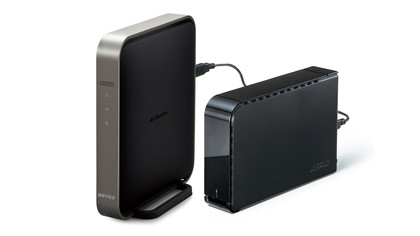Why you can trust TechRadar
Is there any other area of the computing world that over promises more than networking? We're struggling to think of one. True the jump from 802.11g to 802.11n did garner a healthy increase of doubling in speed, but the waters were so muddied by the incompatible MIMO releases and endless 802.11n drafts that by the time the official units appeared it didn't feel like a huge jump.
Once more we're being promised a threefold increase with the Buffalo AirStation 1750, and frankly the reality isn't awe-inspiring.
Partly testing is hampered because there are currently no suitable laptop wireless adaptors, with the first production chipsets expected towards the end of 2012. To get around this, we're going through a Buffalo AirStation D1300 Media Bridge, which unfortunately means there's no way of diagnosing connection speeds.

But since this is specifically designed to work in tandem with the Buffalo AirStation 1750, we're holding our hands up on this area and leaving it to Buffalo to do the work.
At best, we gained average transfer speeds of 30MB/s both upstream and downstream, which is damn fast, but still only around 50 per cent better than average-performance 2.4GHz and 5GHz routers.
It trails the top performing Western Digital N900 Central that managed mid-30MB/s speeds at 5GHz. Annoyingly we did see spikes into the 50MB/s and 40MB/s levels, but only momentarily, and these levels couldn't be reproduced or sustained.

Moving a solid wall away did see a slight drop in speed to 27MB/s on the up and downstream, which represents a better performance at the middle range.
Sign up for breaking news, reviews, opinion, top tech deals, and more.
In a way, the more impressive aspect of the Buffalo AirStation 1750 is its standard 450Mbps performance at 2.4GHz. At a distance of 25m we recorded some of the fastest transfers we've seen, averaging 12MB/s upstream and 8MB/s downstream, speeds that put 100BaseT wired connections to the test.
Two walls away we also recorded 20MB/s average transfers, which is a strong performance. As is often the case, the same-room speed fell off to 16MB/s, which is still among the better performances we've seen.

At 5GHz, its performance wasn't as impressive - again at a distance it averaged very good 7MB/s download and upload speeds. The 5GHz wavelength can suffer more, with an average download of 16.5MB/s through solid walls that attests to this in the one-room away test, as it struggled to get through the walls.
Things did picked up a little, to 17.4MB/s, for the same-room test, but this still lags behind the better router performances that we've seen such as from the Western Digital N900 Central.
